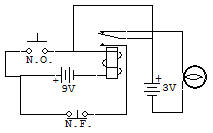

Relay Latching Circuit

The purpose of this project is to study and demonstrate the basic push button control circuit used with relays.
This circuit allows any kind of equipment to be turned ON by one push button and OFF with a second push button. You will find this circuit used on most large power equipment where Relays are normally used for switching. We don't have push button switches to use for this circuit so we will use the Key as one and the switch as the other.
The Key is the same (in function) as the push button switch it represents. That is, it is normally open and must be pressed to be ON.
The Switch replaces a push button which would be a normally closed type; this one must be pressed to open the circuit. These two different types of switches are indicated by the letters N.O. for normally open and N.C. for normally closed.
To operate the Switch as a N.C. switch, keep it in the up position unless it is to be pressed, then only momentarily slide it down and back up.
Connect the circuit and check operation by momentarily actuating the switches in sequence. You should find the following: the Lamp is always turned OFF by the N.O. switch (Key) and ON by the N.C. switch (slide Switch).
Now let's consider how this circuit operates. Use the Schematic to follow the description. The Relay is shown in the de-energized condition (as usually done on Schematics).
When the N.O. switch is closed, the circuit is completed between the Battery and Relay, energizing the Relay. The N.O. contacts of the Relay are closed, and the N.C. contacts are opened (turning the Lamp OFF).
The closed contacts on the Relay complete the Relay coil circuit because these contacts are in parallel with the N.O. switch (Key). This N.O. switch may be left open now as the Relay has locked itself into the ON or energized state. To de-energize the Relay the N.C. switch (in series with the Relay's lock in contracts) need only be momentarily opened, and the Relay drops out (de-energizes).
A separate set of contacts is generally used with this type of relay circuit so the circuit to be controlled can be turned ON and OFF along with the Relay. With only one set of contacts, like this Relay, the circuit is ON when the Relay is OFF and vice versa.
